Sacramento— California is still America’s wine capital, but day trips to Napa and Sonoma counties aren’t what they once were.
Tastings, once free or comped with the purchase of a bottle, have skyrocketed north of $80 at some wineries. Add in the costs and headaches of arranging a ride or booking an Airbnb, and a relaxing getaway starts to come with a sticker shock-induced hangover of its own.
One drinker knew there had to be more out there. So she asked Bee Curious, a community-driven series where The Sacramento Bee investigates and answers readers’ questions on everything from weird sculptures around town to what exactly the Delta Breeze is.
“Where are the best hidden gem wine regions in the area?” Carolyn Dismuke asked Bee Curious.
Dismuke has made a career out of posing (and answering) that question. She’s a nomadic California wine taster currently staying in Placerville, the author of “Drink Your Words: Discovering California’s Other Wine Regions.”
“Many aspects of the wine tasting experience drive people out of Napa and Sonoma but the most common are prices, crowds and attitudes,” Dismuke wrote in a follow-up email earlier this month. “At a tasting room in Placerville yesterday, the owner and winemaker were pouring sharing vineyard stories with patrons from big cities who exclaimed that was why they chose the location.”
California’s capital city is tucked in between more than 200 wineries, according to Visit Sacramento. You can find international producers with local roots, boutique craftsmen and everything in between.
Clarksburg

What to know: Hot sun and Delta breezes help create prime conditions for chenin blanc, Clarksburg’s flagship wine, as well as chardonnay and pinot grigio. For a comprehensive comparison, visit a handful of the Old Sugar Mill’s 14 tasting rooms.
Big name: Bogle Family Vineyards (37783 County Road 144, Clarksburg). Founded in 1978 and still run today by the Bogle family, Bogle Family Vineyards has become one of the United States’ largest producers thanks to its affordable, easy-to-drink wines.
Amador County
What to know: Best known for reds such as barbera, grenache and syrah, Amador’s Shenandoah Valley tends to group its offerings close together.A five-mile cruise down Shenandoah Road passes by at least a dozen wineries including Vino Noceto’s famous sangiovese, Borjon’s explosive tempranillo and Andis’ barbera/zinfandel blend that Corti Bros. store director Rick Mindermann says is quite possibly be the best red in the shop right now.
Big name: Rombauer Vineyards (12225 Steiner Road, Plymouth). Based in St. Helena, Rombauer’s famous chardonnay (known to some as “cougar juice”) can also be enjoyed at its vineyard and tasting room in the Sierra foothills, along with reds from around the area. Be forewarned: a food truck parks outside this tasting room four days per week, but you may want to pack a picnic for other wineries, as full meals can be hard to come by.
Lodi

What to know: Some of America’s best-known zinfandels come from a community just 40 minutes south of downtown Sacramento that produces more grapes of any varietal than Napa and Sonoma combined. That fruit feeds wineries across the state, but Lodi regularly produces world-class wines close to home as well. There’s a noticeable trend of Latino farmworkers’ descendents stepping into winemaking or ownership.
Big name: Michael David Winery (4580 Highway 12, Lodi). Come for the “Freakshow” line of wines that have made Michael David a household name, stay for the more reserved options and an onsite cafe/bakery that sources veggies from the property and meat from local 4-H programs.
El Dorado County
What to know: Amador’s cousin in the Sierra Nevada foothills bears more than 70 wineries, from Apple Hill to the Fair Play AVA’s many wine caves. Rocky soil, sunny days and hints of crisp mountain air contribute to a long growing season, and reds such as zinfandel and grenache rule the day up here.Big name: Boeger Winery (1709 Carson Road, Placerville). It’s easy to mix up Bogle and Boeger — both started their respective regions’ modern wine scenes in the 1970s, and both remain reasonably-priced options today. But Boeger is best-known for its barbera and “Hangtown Red” blend, while the family’s friends in Clarksburg are best known for their petite syrah and chardonnay.
Yolo County
What to know: With ample farmland and UC Davis’ renowned enology and viticulture school in its backyard, it’s no wonder Yolo County has its own burgeoning wine scene — especially if one includes Clarksburg, which is within county limits but sort of its own animal. Petite sirah grows well here, as do whites such as chardonnay, chenin blanc and albariño.Big name: Matchbook Wines (12300 County Road 92B, Zamora). With 1,700 acres of winegrapes and 350 acres of Spanish and Greek olives, Matchbook’s home base in the Dunnigan Hills AVA is a great place to enjoy high-quality bottles of chardonnay and tempranillo that retail for around $15-$20.
Placer County
What to know: Placer County’s modern wineries only started planting in the 1980s. Four decades later — in the Prohibition era — it boasted more than 20 wineries. Full-bodied reds such as zinfandel, barbera and syrah are the most common varietals, as in much of the Sierra foothills; try a viognier if you’re more into whites.Big name: Mt. Vernon Winery (10850 Mt. Vernon Road, Auburn). A converted 1950s milk house now functions as the Taylor family’s tasting room, with vineyard views and a $15 tasting fee waived upon purchase of a bottle.
Three more to visit: Secret Ravine Vineyard & Winery (4390 Gold Trail Way, Loomis), Vina Castellano Winery (4590 Bell Rd, Auburn), Ciotti Cellars (3285 Crosby Herold Road, Lincoln).






